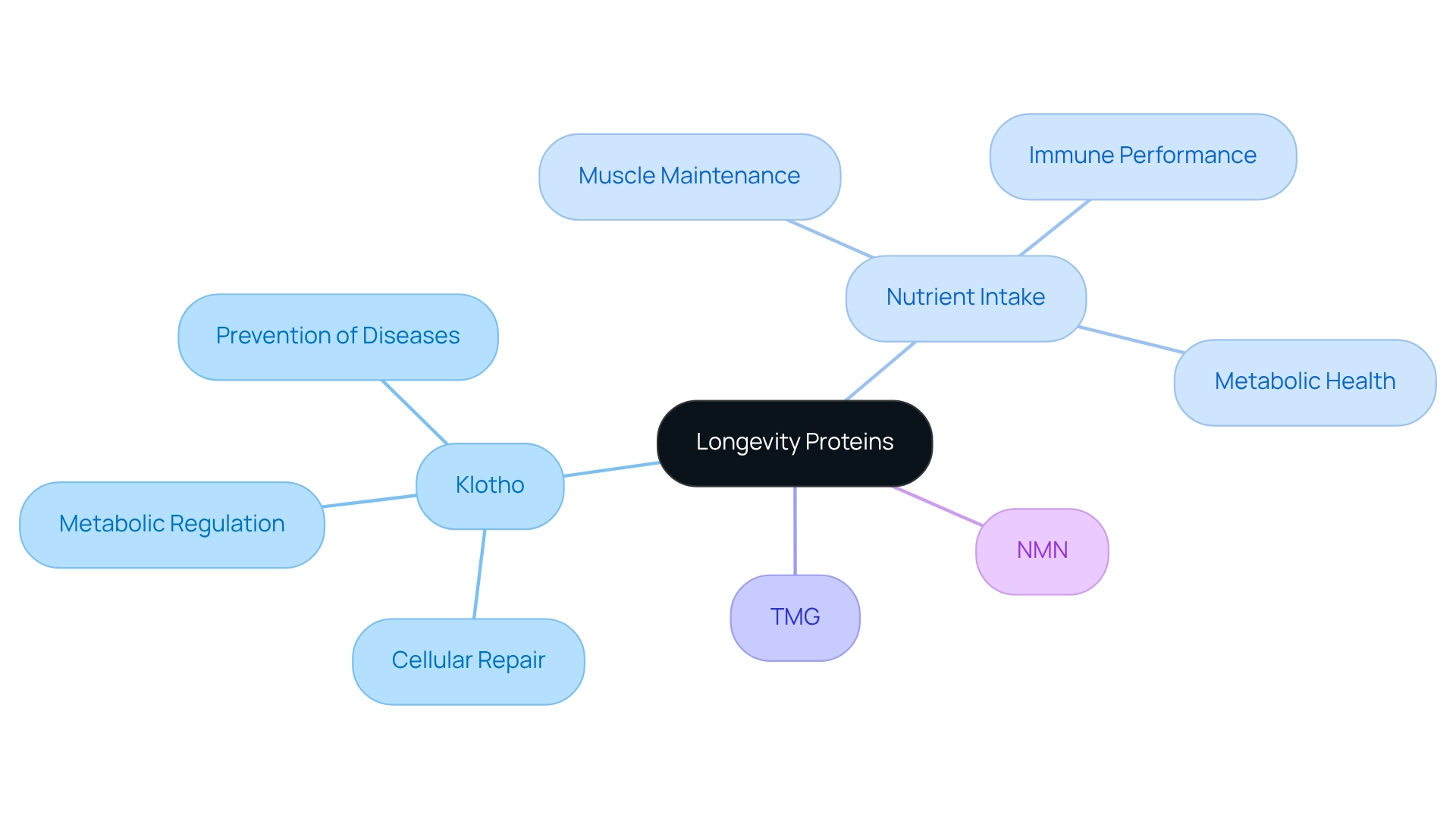Understanding Longevity Protein: Origins, Benefits, and Dietary Tips
Overview
The article explores the origins, benefits, and dietary tips related to longevity proteins, highlighting their crucial role in enhancing well-being and potentially extending lifespan. It underscores the importance of proteins like Klotho in various biological processes. Furthermore, it suggests that incorporating nutrient-dense foods, such as beef liver and ribeye steak, along with a clear understanding of nutrient synergy, can significantly improve health outcomes and support successful aging. By embracing these dietary choices, individuals can take proactive steps towards better health and longevity.
Introduction
In the quest for a longer, healthier life, longevity proteins have emerged as a focal point in nutritional science. These remarkable proteins, such as Klotho, play a pivotal role in enhancing health and hold the potential to extend lifespan by influencing critical biological processes. They promote cellular repair and regulate metabolism, showcasing a profound impact on aging.
As research continues to unveil the intricate relationship between diet and longevity, understanding how to effectively incorporate these proteins into daily nutrition becomes essential for anyone seeking to improve their overall well-being.
This article explores the significance of longevity proteins, their historical context, and practical dietary strategies to harness their benefits for a vibrant, age-defying life.
Define Longevity Protein: Key Concepts and Importance
Longevity proteins are specific substances recognized for their essential role in enhancing well-being and potentially extending lifespan. A prominent example is Klotho, which is associated with crucial biological processes, including cellular repair, metabolic regulation, and the prevention of age-related diseases. Research has shown that Klotho influences the aging process by improving kidney function and regulating calcium and phosphate metabolism. For those aiming to boost their wellness as they age, understanding the impact of these enduring substances is vital, as they significantly contribute to overall health and vitality.
Incorporating adequate sources into the diet is essential, as it supports muscle maintenance, immune system performance, and metabolic health—key factors for successful aging. Recent studies underscore the importance of nutrient intake, revealing that sufficient consumption can lead to improved well-being and a reduction in age-related decline. Furthermore, investigating the synergy between nutrients like TMG and NMN can enhance cellular function; TMG provides methyl groups that NMN depletes, optimizing cellular efficiency. Personal anecdotes regarding TMG and NMN supplementation highlight the tangible benefits these nutrients offer in promoting longevity. As individuals focus on extending their lifespan, grasping the influence of longevity protein and complementary nutrients on well-being becomes increasingly crucial.

Trace the Origins of Longevity Protein: Historical and Scientific Context
The study of life-extending substances has its roots in early 20th-century investigations into aging, which initially examined the connection between diet and lifespan. These foundational studies uncovered that specific dietary components could considerably affect longevity. As research progressed, scientists identified key molecules, notably Klotho, associated with increased lifespan and a lower risk of chronic diseases. Advances in molecular biology and genetics have elucidated the mechanisms through which these molecules function, enhancing our understanding of their crucial roles in aging.
Recent studies suggest that targeting proteins like Klotho may provide promising therapeutic strategies for age-related conditions. For example, in one mouse model, the injection of UBX0101 demonstrated a reduction in proteoglycan loss and alleviated cartilage degradation linked to osteoarthritis. This highlights the potential of such breakthroughs in aging research. Furthermore, Dr. Dituri’s innovative underwater research suggests that alternative environments might influence human well-being and lifespan, paving the way for new approaches to incorporating environmental factors into anti-aging treatments. As of 2025, ongoing research continues to reveal new longevity proteins, highlighting the crucial role of diet in promoting health and longevity protein. This evolving understanding emphasizes the importance of integrating nutrient-dense foods into our diets to support healthy aging. Additionally, the initiatives of Sierra Sciences, founded by William H. Andrews, showcase a commitment to addressing human senescence through pioneering research. Insights from case studies on epigenetic changes in the elderly further illustrate the complexity of this process and the significance of substances like Klotho.
Including citations from leading researchers in age-related studies, such as Dr. Dituri, who stated, ‘Our understanding of how environmental factors can enhance lifespan is just beginning,’ could enrich this discussion by providing direct insights into the origins and significance of longevity-related molecules. Moreover, the role of rapamycin—a compound that modulates cellular processes involved in aging—highlights the potential for innovative anti-aging therapies that target fundamental pathways implicated in the longevity protein.
Examine Key Characteristics of Longevity Protein: Nutritional Components and Benefits
Longevity proteins are defined by their specific amino acid composition, bioavailability, and functional roles within the body. High-quality nutrients, particularly those derived from animals, provide essential amino acids crucial for muscle repair and maintenance. For instance, collagen and whey substances are recognized for their beneficial effects on skin condition and muscle development, contributing to a more youthful appearance and physical vitality. Incorporating longevity protein through cooking methods, such as searing ribeye steaks, enhances both the taste and nutritional value of these foods, making them a delicious addition to an anti-aging diet.
To prepare ribeye steaks, take them out of the refrigerator about 30 minutes prior to cooking to allow them to reach room temperature. Pat them dry, season generously with salt and pepper, and heat olive oil in a cast-iron skillet until shimmering. Sear the steaks for approximately 4-5 minutes on each side, adding grass-fed butter for basting, which further enriches the dish.
Furthermore, studies indicate that substances like Klotho, known as a longevity protein, can improve metabolic well-being and reduce inflammation, both essential for preventing age-related illnesses. Research has also shown that in malnourished older adults, short-term nutrient supplementation significantly enhanced dietary intake and lean body mass, underscoring the importance of adequate nutrient consumption in this demographic.
In addition, the Prospective Urban-Rural Epidemiology (PURE) study found that grip strength is inversely related to all-cause mortality, highlighting the significance of muscle strength in overall wellness outcomes. To enhance well-being and lifespan, it is beneficial to incorporate a diverse selection of nutrient sources, particularly those rich in longevity protein from both animal and plant-based options. This strategy not only maximizes the intake of essential amino acids but also supports overall well-being as individuals age.
The challenge for the next century is to determine whether interventions on aging can improve both lifespan and health span. How can we leverage our understanding of nutrition and muscle strength to promote longevity? Exploring these questions may lead to valuable insights into enhancing our quality of life as we age.
Implement Longevity Protein in Your Diet: Practical Examples and Recipes
Incorporating long-lasting nutrients into your meals can be both enjoyable and beneficial. Here are some practical examples and recipes to consider:
- Savory Beef Liver Patties: Beef liver is a nutrient powerhouse, offering high-quality nourishment along with essential vitamins and minerals that contribute to the production of longevity protein. Its rich nutritional profile makes it a valuable addition to a balanced diet, contributing to immune and nervous system health. A case study titled ‘Beef Liver’s Role in a Balanced Diet’ highlights its elevated nutrient content and low calorie count, which can aid various bodily functions.
- Perfectly Seared Ribeye Steak: This cut of meat is not only delicious but also provides a significant amount of nutrients and healthy fats, essential for muscle maintenance and overall vitality. Regular consumption can help sustain energy levels and promote a healthy body composition. Nutritional analysis shows that ribeye steak is rich in essential nutrients that support overall health. Anti-aging enthusiasts note that including quality animal-based foods like ribeye can be a key component of a diet rich in longevity protein.
- Plant-Based Nutritional Smoothies: For a nutrient-rich breakfast, blend spinach, banana, and a scoop of plant-derived powder. This combination offers a refreshing way to start your day while supporting longevity protein through a balanced intake of vitamins and minerals.
- Quinoa Salad with Nuts and Seeds: Quinoa serves as a complete source of essential nutrients, and when combined with nuts and seeds, it creates a balanced meal abundant in amino acids and healthy fats. This dish not only satisfies hunger but also enhances overall well-being.
By incorporating these foods into your meals, you can boost your consumption of beneficial proteins while enjoying a varied and tasty diet. Each recipe promotes well-being and aligns with nutritional guidelines for longevity protein, making it easier to adopt a lifestyle that fosters vitality. Studies indicate that including more foods rich in longevity protein in your diet can significantly contribute to better health outcomes, with metformin showing a protective effect against certain cancers, reducing risks by as much as 40 percent. This foundational information, established early in life, informs the body on how to rejuvenate—akin to a backup of the original data.
Conclusion
Longevity proteins play a vital role in enhancing health and potentially extending lifespan. Proteins such as Klotho are essential for cellular repair and metabolic regulation, making them crucial for individuals aiming to improve their well-being as they age. Adequate protein intake supports muscle maintenance, immune function, and overall vitality, underscoring its significance in healthy aging.
Research has established a strong connection between diet and longevity. Advances in molecular biology have revealed how these proteins function, highlighting the importance of understanding the synergistic effects of various nutrients. This knowledge can optimize the benefits of longevity proteins, providing promising avenues for addressing age-related health issues.
Incorporating high-quality animal and plant-based proteins into the diet can significantly enhance the intake of these essential nutrients. Enjoyable recipes featuring nutrient-rich foods, such as beef liver and quinoa, align with nutritional guidelines aimed at promoting longevity.
Prioritizing longevity proteins in daily nutrition is crucial for fostering overall well-being and improving quality of life. As our understanding of these proteins continues to evolve, adopting a diet rich in longevity-focused foods empowers individuals to take proactive steps toward a healthier, more vibrant life as they age.
Frequently Asked Questions
What are longevity proteins and why are they important?
Longevity proteins are specific substances that play a crucial role in enhancing well-being and potentially extending lifespan. They are essential for biological processes such as cellular repair, metabolic regulation, and the prevention of age-related diseases.
What is Klotho and what role does it play in aging?
Klotho is a prominent longevity protein associated with important biological processes. It influences the aging process by improving kidney function and regulating calcium and phosphate metabolism, which are vital for overall health.
How can diet impact wellness as we age?
Incorporating adequate sources of longevity proteins and nutrients into the diet is essential for supporting muscle maintenance, immune system performance, and metabolic health, all of which are key factors for successful aging.
What does recent research say about nutrient intake and aging?
Recent studies highlight that sufficient nutrient consumption can lead to improved well-being and a reduction in age-related decline, emphasizing the importance of diet in the aging process.
How do TMG and NMN work together to enhance cellular function?
TMG (Trimethylglycine) provides methyl groups that NMN (Nicotinamide Mononucleotide) depletes, optimizing cellular efficiency and enhancing overall cellular function.
Are there personal experiences that support the benefits of TMG and NMN supplementation?
Yes, personal anecdotes regarding TMG and NMN supplementation indicate that these nutrients offer tangible benefits in promoting longevity and overall well-being.
Why is understanding longevity proteins and nutrients increasingly crucial for individuals?
As individuals focus on extending their lifespan, understanding the influence of longevity proteins and complementary nutrients on well-being becomes vital for maintaining health and vitality as they age.






